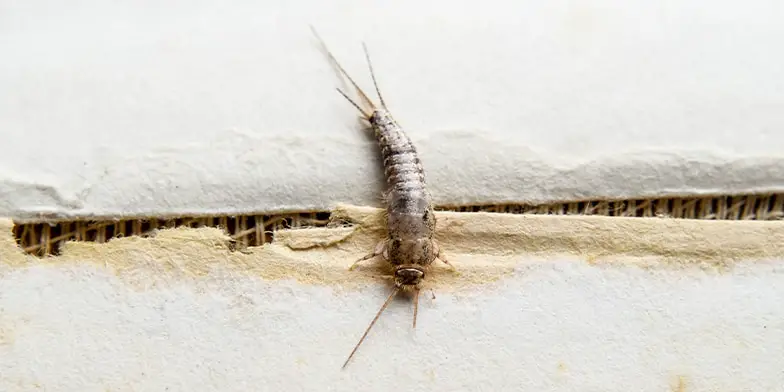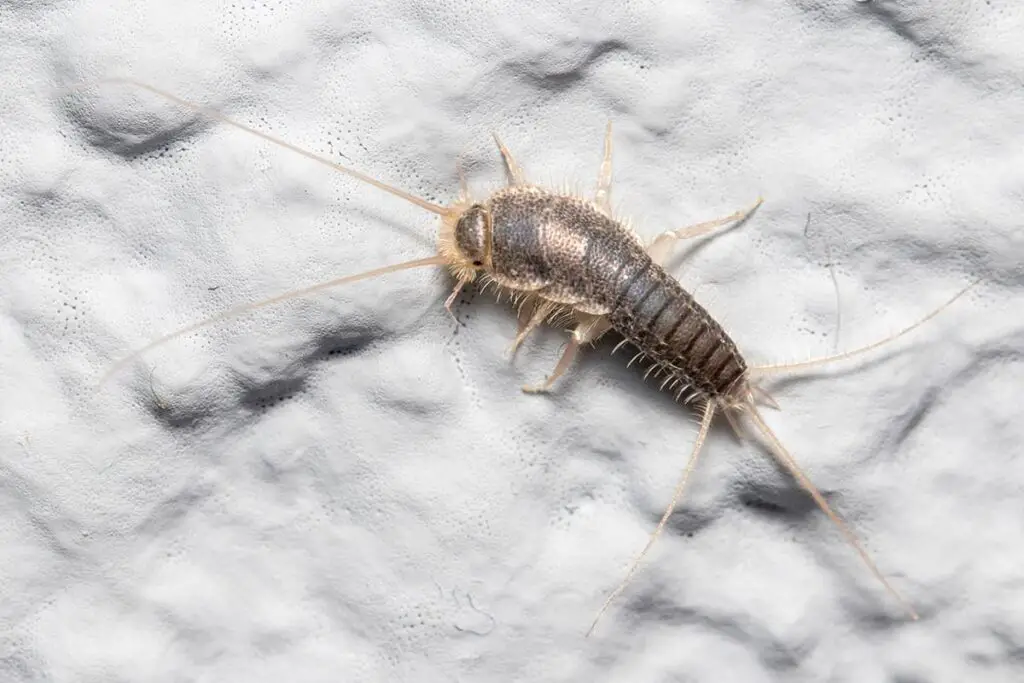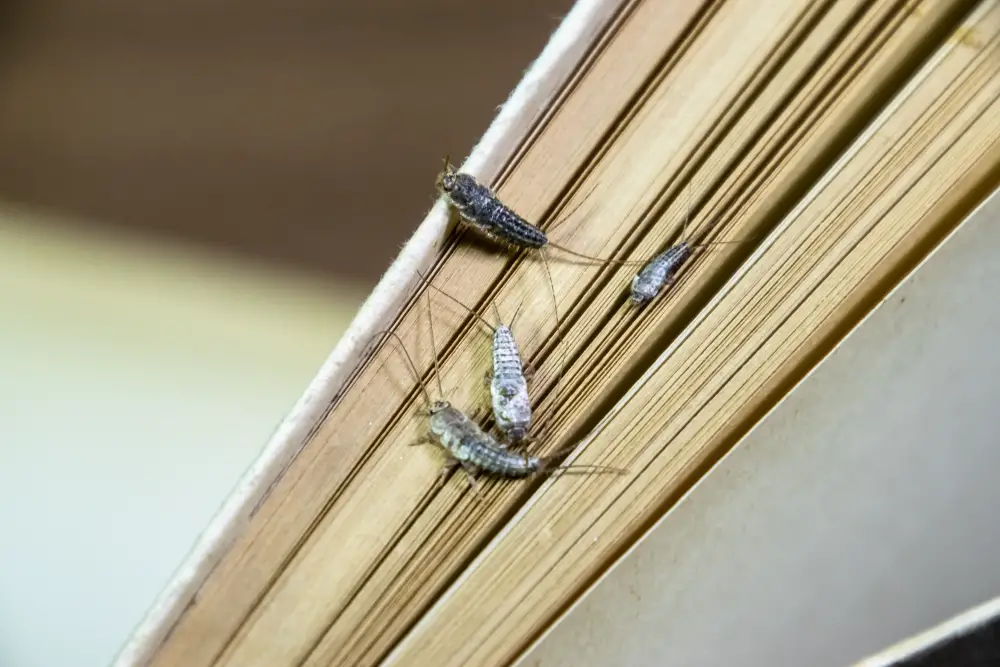
Regardless of where you are in the world, there’s a good chance that you have at some point encountered these little critters; Silverfish are prevalent in America, Africa, Australia, Eurasia, and even areas of Europe. With such an array of places where the insect appears to thrive, and more importantly, how often they appear in people’s houses, people may wonder: do Silverfish have nests, and if so, where?
Silverfish thrive best in damp areas with high humidity, and within the temperature of 70-80 degrees Fahrenheit or 21-26 degrees Celsius. In outside areas Silverfish make nests under loose tree bark or rocks, or in the homes of other animals such as birds, rodents, and other nest building insects like termites. Cool weather may drive them indoors, where they most often make their nests around heating and water pipes.
So Silverfish do make nests, and often both indoors and outdoors, but I’m sure most of us would rather it be outdoors than indoors, so let’s discuss why Silverfish make their nests in the places they do, and what can be done to keep them more to the outside than inside our homes.
Why Do Silverfish Have Nests?
Silverfish may be hardy enough to survive in many places throughout the world, but its need for moisture is actually quite specific. In too much water, they will drown, in too little, they will dry out and die. Therefore they need to settle down in an area that is reliably wet, and yet will also protect both them and their eggs from the rain. They also require to be in a particular temperature range, and do not hibernate through winter, unlike many other insects. Naturally, like most other creatures, if they can set up a base in an area with plentiful food, they will take it. Unfortunately, this little list of requirements, ie:
- Has water, yet protects from rain
- Between 70-80 degrees F (Or 21-26 degrees C)
- Plentiful food nearby
Sounds an awful lot like what humans would also require from a home, which means that inevitably, Silverfish do find themselves inside our homes, especially when the harsh temperatures of winter come around and a human house is so much cosier and warmer than the outside. There are some particular features about your home which makes a good nest for them.
Moist Corners Are Perfect For Silverfish Nests
As we mentioned before, moisture is key for Silverfishs’ survival. They will drown in submerged areas, but softly moist areas are perfect for keeping both Silverfish and their eggs hydrated. There are some areas of our homes which always are, and always will be, damp. Sinks, showers and bathtubs will hardly work without water, so finding a Silverfish or two there is not uncommon, especially since the drains leading out of our homes can act as a good entry point for them. They will also enjoy areas with a lot of water pipes for this exact reason, so they can also be found in kitchens and laundry rooms. Plus, moisture has the added advantage for Silverfish (but disadvantage for us) that undue dampness will cause mould to grow on wooden structures, which may soften it enough to act as a nice entranceway for the bugs.
Areas With Plenty of Food Are Perfect For Silverfish Nests
Now, we just mentioned kitchens, and yes, kitchens are the perfect place for Silverfish nests because of all the dried cereals, oats and other treats we keep stashed away in them, but when we say ‘areas with plenty of food’, we are also referring to basements, attics, laundry rooms, and almost anywhere in your home because these suckers will eat almost anything! Silverfish will happily feast on almost anything carbohydrate. This includes:
- Paper
- Glue
- Carpet
- Clothes
- Insulation
- Old carboard boxes
- Book bindings
- Even soap and shampoo in some cases
Therefore, even if you manage to keep them out of that packet of oatmeal you have stashed away in the kitchen, your home is still a treasure trove of tasty treats for Silverfish – and a very tempting place to build a nest.

Dark Places Are Perfect For Silverfish Nests
Silverfish are very much nocturnal creatures and gather in all manner of dark places to avoid bright lights, and what would you know it? The human house is full of little nooks and crannies for a tiny insect to be able to hide itself in. Everywhere from within cupboards and wooden beams of houses to within the walls themselves offer a hiding space for a Silverfish, which is perfect for avoiding the light, and predators such as spiders which might want to snack on them.
Calm Areas Are Perfect For Silverfish Nests
You may have picked up from the last section especially that Silverfish are not the confrontational type. They are defensive, and generally do everything they can to avoid being caught out by larger creatures. (From this, I can also give you the good news that they don’t bite, in case that was something that worried you). The human home is full of lovely, rarely touched areas where they are unlikely to be disturbed on their nightly activities, such as basements and attics which we don’t tend to go into as much as other rooms, some of these crevices we can’t reach into.
How To Avoid A Silverfish Making Its Home In Yours
So, we have officially combed over all the ways in which a human home is a perfect place for a lone Silverfish to make its nest. Presumably, most people don’t want a thousand little silver insects living rent free in their abode, though, so how do you make sure they don’t? Well, there are a few things you could do to make sure you don’t end up with an infestation of Silverfish this winter.
Reduce the moisture
Make those dark, moist corners of your home just a little bit less damp with dehumidifiers, air-conditioners and ventilated fans. Remember, if you end up with a Silverfish nest in somewhere which shouldn’t be damp enough for it, then make sure you check thoroughly to ensure there’s not a leak somewhere. Wipe out bathtubs and sinks after you use them and be certain your gutters are working properly to keep water away from the house rather than flowing in.
Declutter And Clean Regularly
This will clear out potential nesting areas for Silverfish, especially if you have stacks of old papers and clothing in convenient piles. Vacuum to suck out any hidden critters from cracks where you might not see them and store both food and clothes in plastic containers since they can’t chew through that.
Seal Up Any Cracks And Entry Points
One of the easiest ways in which these insects get in is through gaps in the house’s foundation or through that little space between the window and the wall. Use caulk, expanding foam or any other measures to fill in these gaps and block access to your home.
Make Your Home Smelly
If you are particularly worried, there are some extra measures you can take to protect your home, and these involve using scents to drive the insects away. You can use over the counter spray insecticide for this, or place moth balls near suspected or possible nesting sites. If you prefer a more natural route for this, Silverfish hate many natural smells including lavender, cedar and cloves.
Call The Experts If It’s Too Much
If the number of Silverfish in your home has completely spun out of control, then pest exterminators are very well equipped to handle the situation. If you suspect of a truly uncontrollable infestation, then you’re best off calling the experts.
Conclusion
Silverfish do make nests, providing the area they are in is warm, moist but not wet, and allows them to stay in the dark and the quiet. These parameters mean that human homes are very attractive prospects to build their nests in, especially in the winter months seeing that they are insects that don’t hibernate. However, you can do a little something to protect your home from becoming a nest by reducing the moisture, blocking off entry points, decluttering, and by laying down repellents.
Driven by a passion for those tiny creatures that rule our world, we at Bug Domain strive to be your go-to resource for information on insects.




